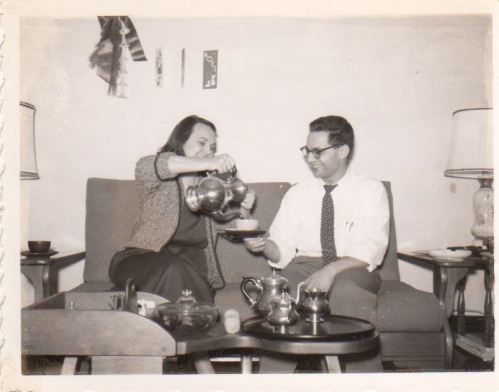
I didn’t intend on eating dinner twice last night. Our first dinner — a healthified version of General Tso’s Chicken — certainly sufficed. But life can be surprising at times. Let me explain.
My husband and I had settled into our lazy Sunday night routine of watching Animation Domination on the tube when our doorbell rang. At 8:30 pm. Now, in my idyllic country life, an unexpected visitor would be part of day-to-day life. But we are city folks now. And when the doorbell rings at that time of night with no forewarning, you do what any good urban paranoid does: pretend you’re not home. Never mind the fact that it’s dusk and the car is in the driveway and there are lights on in every room of the house. If we don’t move or say anything, they’ll go away, right?
Not so. The doorbell rang again. I sent my intrepid husband off to investigate. He returned a few moments later with a heretofore unseen cooler and a perplexed look on his face. “The neighbor… He just came by with lobsters.” While I don’t wish to downplay the unusual nature of this occurrence, I should explain that our neighbor has a boat. And goes lobstering in his free time. “He said they were ‘extra’.”
Extra lobsters? I began feeling somewhat perplexed myself.
“Um… so…what do we DO?”
We regarded one another.
“I mean, they’re alive, right?”
We regarded the cooler. Suspiciously.
There was only one thing to do. It was time for second supper. It was also clearly time to call in the big guns. I needed help. I needed Julia Child.
I went upstairs and pulled a copy of Mastering the Art of French Cooking from my bedside reading pile. I had never cooked lobster before. Julia would show me the way to a perfect meal — of that, I was confident. I flipped through the pages and found three recipes for lobsters. Predictably, I proceeded to perform a terrible impression of Julia’s voice as I started reading off the procedure for killing the mighty crustaceans, punctuating the more graphic parts by brandishing a large chef’s knife.
As my continuing good luck would have it, I had a good assortment of ingredients in my fridge and pantry, having gone grocery shopping that afternoon and still having a plethora of herbs and veggies left over from the previous weekend’s barbecue. Everything I needed was on hand to make Homard aux Aromates [Lobster Steamed in Wine with Herb Sauce]. At 9:30 on a Sunday night, I threw the mirepoix and some wine into a stockpot and got the cooking underway. Once the broth was ready, Mr. M and I steeled ourselves to the task at hand, reached into the cooler with trepidation, and took turns tossing our clawed pets into the pot. We steamed those suckers alive.
We finally feasted on our six lobster halves at 11 pm, toasting our good fortune with Coronas grasped in sticky hands. Was I tired at work today? You betchya. Would I have it any other way? Of course not. Because when life hands you lobsters, you eat them. No matter what the time.
Homard aux Aromates [Lobster Steamed in Wine with Herb Sauce]
my translation of the recipe by Julia Child
To steam lobsters
- 3 cups dry white wine
- 2 cups water
- 1 large onion, thinly sliced
- 1 medium carrot, thinly sliced
- 1 celery stalk, thinly sliced
- 6 parsley sprigs
- 1 bay leaf
- ¼ teaspoon dried thyme
- 6 peppercorns
- 1 tablespoon fresh tarragon, chopped
- 3 live lobsters
For sauce
- 1½ tablespoons flour
- 1½ tablespoons softened butter
- 1 cup whipping cream (or, in my case, a half cup of 2% milk and a big splash of fat-free fake creamer. Don’t judge. It’s called “making do”.)
- 4 tablespoons minced parsley
Simmer wine, water, vegetables, herbs and seasonings in a large stock pot for 15 minutes. Bring to a boil and toss in the live lobsters. Cover and boil for 20 minutes. Lobsters should be bright red, and you should be able to pull the feelers on the head out of their sockets fairly easily. Remove lobsters and set aside.
Discard the bay leaf, peppercorns, and large pieces of parsley. Transfer the remaining mixture to a saucepan, bring to a boil, and reduce to about 2 cups. Meanwhile, blend the flour and butter into a paste with a spoon in a small bowl. Remove the sauce from the heat and whisk in the flour paste. Return to heat and bring to a boil for 15 seconds. Reduce to a simmer and stir in the cream one tablespoon at a time, until it is the consistency of a cream soup. (Or so says Julia. My impression of a cream soup used only half the called for amount of milk. So I stopped there, and my cat got a treat.) Taste; add salt, pepper or a squeeze of lemon to correct the seasoning as needed.
Using a strong chef’s knife, split the lobsters in two lengthwise, trying not to crush the shell. Remove the sacks in the head as well as the intestines. You can also remove the coral and “green matter” (also known as the tomalley) if you wish. I had no idea what “coral,” was, but figured it out pretty quickly after I cut into my first female lobster. (It’s all that funny-looking pink stuff in the photo below.) Since Mr. M & I are not lobster connoisseurs, I opted to clean out everything except the meat.
Arrange the lobsters in a serving dish, and pour the sauce over the top. Gussy up with parsley and lemons if you wish. Serve with plenty of napkins.























